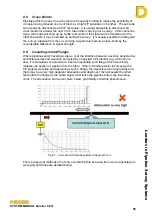
Leaders in Pipelin
e Survey Systems
C
C
C
-
-
-
S
S
S
C
C
C
A
A
A
N
N
N
2
2
2
0
0
0
1
1
1
0
0
0
SYSTEM MANUAL Version 6.03i
52
7.10. Long Term Program
A long term survey programme and good record keeping is essential if the full benefit is to
be obtained from this equipment. After the baseline survey has been completed, the
following approach is suggested:
a) Carry out a general survey of whole pipeline at intervals of around 1,000ft (shorter on
high risk sections). Specific fault/anomaly location only on sections with very high
attenuation.
b) Study the results of (a) above and draw up a programme of specific fault/anomaly
location for the highest risk sections (say 10-30% of the whole line) taking account of
the extent to which the CP System can cope with minor faults.
c) When a programme of fault location has been drawn up, survey the relevant section
immediately before and after the repair work.
d) Where any excavations, building work, pipe laying, road works, etc., are to take place
near the pipeline, arrange for a check survey of the relevant section before and after the
work to establish the responsibility for any resultant damage.
e) Repeat (a) periodically (say every 1-2 years), if possible taking readings at exactly the
same places each time to facilitate comparisons and the identification of rates of
pipeline deterioration.
f) Correlate data on local mB/m losses (or percentage current loss) with actual fault sizes
for different coatings, sizes of pipe and soil conditions, and correlate CP current drain
with local attenuation rates to improve the predictive value of the data collected.
7.11. High Soil Resistivities
If the earth resistance is extremely high, it may not be possible to obtain a useful signal
current, even with all the available
Earth Spikes
in use. This may occur in extremely dry
terrain (desert or semi-desert) or where there is only a thin covering of soil over rock with a
high electrical resistance (e.g. granite). In this situation it may be necessary to prepare a
special ‘ground bed’ to minimise the resistance. This can be done by laying a
Spike
on a
sheet of aluminium foil which is placed in a trench, covered with water, and buried.
In extremely high resistivity soils, the resistivity is of the order of the pipeline coating. In
this case only serve faults can be found unless the survey is carried out during the wet
season when the soil resistivity drops significantly. This is demonstrated on the following
graph:















































